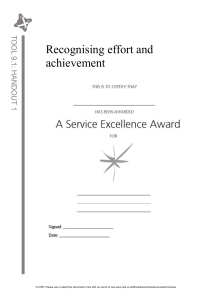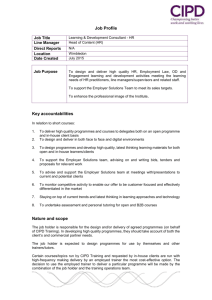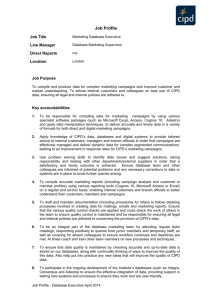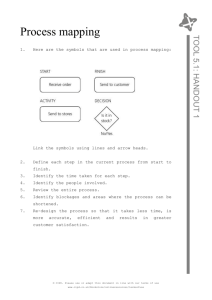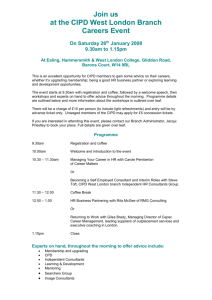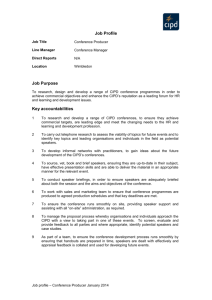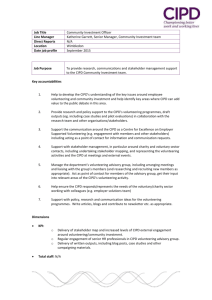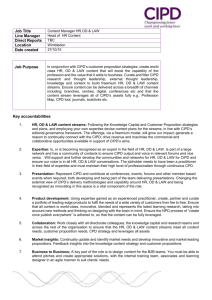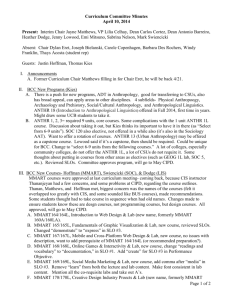Building an excellent reputation
advertisement
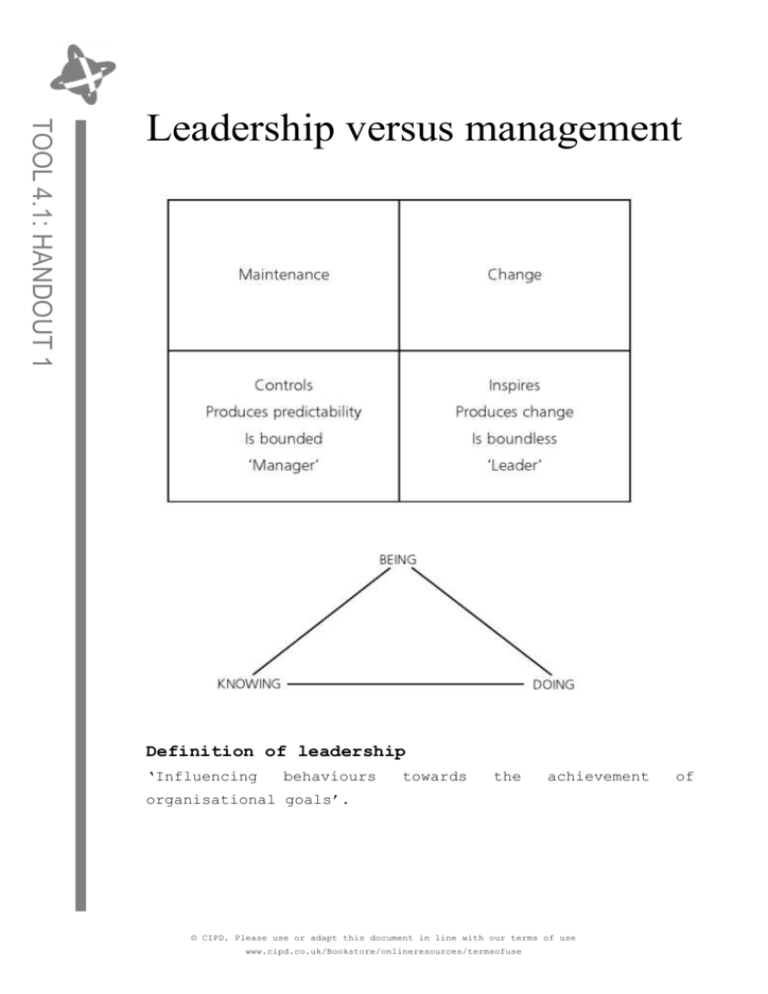
TOOL 4.1: HANDOUT 1 Leadership versus management Definition of leadership ‘Influencing behaviours towards the achievement organisational goals’. © CIPD. Please use or adapt this document in line with our terms of use www.cipd.co.uk/Bookstore/onlineresources/termsofuse of What are the key learning points from this session? ___________________________________________________________ ___________________________________________________________ ___________________________________________________________ ___________________________________________________________ ___________________________________________________________ ___________________________________________________________ ___________________________________________________________ ___________________________________________________________ __________________ What percentage of your time do you spend managing and what percentage leading? ___________________________________________________________ ___________________________________________________________ ___________________________________________________________ ___________________________________________________________ ___________________________________________________________ ___________________________________________________________ ___________________________________________________________ ___________________________________________________________ __________________ What do you need to do differently? ___________________________________________________________ ___________________________________________________________ ___________________________________________________________ ___________________________________________________________ ___________________________________________________________ ___________________________________________________________ ___________________________________________________________ ___________________________________________________________ __________________ © CIPD. Please use or adapt this document in line with our terms of use www.cipd.co.uk/Bookstore/onlineresources/termsofuse TOOL 4.1: HANDOUT 2 Leadership versus management TOOL 4.2: HANDOUT 1 World-class service leadership actions External customer actions • Leaders listen to their customers. • Leaders champion the voice of the customer. Internal customer actions • Leaders listen to their employees. • Leaders stay in touch with their employees. • Leaders support their employees. • Leaders serve their employees. © CIPD. Please use or adapt this document in line with our terms of use www.cipd.co.uk/Bookstore/onlineresources/termsofuse Leaders listen to their customers • What regular mechanisms do you use to ‘listen’ to your customers? ______________________________________________________ ______________________________________________________ ______________________________________________________ ______________________________ • How effective are they? ______________________________________________________ ______________________________________________________ ______________________________________________________ ______________________________ • How can you improve upon this? ______________________________________________________ ______________________________________________________ ______________________________________________________ ______________________________ Leaders champion the voice of the customer • What action have you taken in the last six months to champion the customer’s perspective? ______________________________________________________ ______________________________________________________ ______________________________________________________ ______________________________ • What improvements have you instigated in the past six months to ensure customer loyalty? ______________________________________________________ ______________________________________________________ ______________________________________________________ ______________________________ © CIPD. Please use or adapt this document in line with our terms of use www.cipd.co.uk/Bookstore/onlineresources/termsofuse TOOL 4.2: HANDOUT 2 World-class service leadership actions © CIPD. Please use or adapt this document in line with our terms of use www.cipd.co.uk/Bookstore/onlineresources/termsofuse • How can you improve upon this? TOOL 4.2: HANDOUT 2 ______________________________________________________ ______________________________________________________ ______________________________________________________ __________________ Leaders listen to their employees • What regular mechanisms do you use to ‘listen’ to your employees? ______________________________________________________ ______________________________________________________ ______________________________________________________ ______________________________ • How effective are they? ______________________________________________________ ______________________________________________________ ______________________________________________________ ______________________________ • How can you improve upon this? ______________________________________________________ ______________________________________________________ ______________________________________________________ ______________________________ Leaders stay in touch with their employees • How often do you shadow your team to see how they’re doing? ______________________________________________________ ______________________________________________________ ______________________________________________________ ______________________________ • When did you last spend a full day undertaking the role of one of your team? ______________________________________________________ ______________________________________________________ © CIPD. Please use or adapt this document in line with our terms of use www.cipd.co.uk/Bookstore/onlineresources/termsofuse ______________________________________________________ ______________________________ © CIPD. Please use or adapt this document in line with our terms of use www.cipd.co.uk/Bookstore/onlineresources/termsofuse • How often do you brief your team on company performance? ______________________________________________________ ______________________________________________________ ______________________________ • How can you improve communications with your team? ______________________________________________________ ______________________________________________________ ______________________________________________________ ______________________________ Leaders support their employees • Have all of your team members had a full performance appraisal in the last six months? ______________________________________________________ ______________________________________________________ ______________________________________________________ ______________________________ • Do all of your team have a specific and actionable training and development plan? ______________________________________________________ ______________________________________________________ ______________________________________________________ ______________________________ • What recognition methods do you use and how could they be improved? ______________________________________________________ ______________________________________________________ ______________________________________________________ ______________________________ • How empowered are your team to make things rights for their customers when they go wrong, and how could these be improved? ______________________________________________________ © CIPD. Please use or adapt this document in line with our terms of use www.cipd.co.uk/Bookstore/onlineresources/termsofuse TOOL 4.2: HANDOUT 2 ______________________________________________________ ______________________________________________________ ______________________________________________________ ______________________________ © CIPD. Please use or adapt this document in line with our terms of use www.cipd.co.uk/Bookstore/onlineresources/termsofuse TOOL 4.2: HANDOUT 2 Do all of your team have the right tools to enable them to be as productive as possible, and how can you improve this situation? ________________________________________________________ ________________________________________________________ ________________________________________________________ ____________________________________ Leaders serve their employees • Do you always deliver on your promises to your team? ________________________________________________________ ________________________________________________________ ________________________________________________________ ____________________________________ • What regular methods do you use to motivate your team? ________________________________________________________ ________________________________________________________ ________________________________________________________ ____________________________________ • How quickly do you act on their ideas? ________________________________________________________ ________________________________________________________ ________________________________________________________ ____________________________________ • What are the key barriers that stop your team being as effective as they could be, and how can you remove those barriers? ________________________________________________________ ________________________________________________________ ________________________________________________________ ____________________________________ © CIPD. Please use or adapt this document in line with our terms of use www.cipd.co.uk/Bookstore/onlineresources/termsofuse TOOL 4.3: HANDOUT 1 Model of performance © CIPD. Please use or adapt this document in line with our terms of use www.cipd.co.uk/Bookstore/onlineresources/termsofuse • What is the leadership style that you identified for yourself? ___________________________________________________________ ___________________________________________________________ ___________________________________________________________ ___________________________________________________________ ___________________________________________________________ _______________________________________________________ • How can you verify this from other people? ___________________________________________________________ ___________________________________________________________ ___________________________________________________________ ___________________________________________________________ ___________________________________________________________ _______________________________________________________ • What is the impact of your style on your team and the customer? ___________________________________________________________ ___________________________________________________________ ___________________________________________________________ ___________________________________________________________ ___________________________________________________________ _______________________________________________________ • Write down one thing you will do to help yourself adopt a more supportive and challenging climate. ___________________________________________________________ ___________________________________________________________ ___________________________________________________________ ___________________________________________________________ ___________________________________________________________ _______________________________________________________ © CIPD. Please use or adapt this document in line with our terms of use www.cipd.co.uk/Bookstore/onlineresources/termsofuse TOOL 4.3: HANDOUT 2 Reflection sheet TOOL 4.4: HANDOUT 1 Creating our vison of the future Use the following questions as prompts. Write your responses below: Imagine things are going 100 per cent right for the team and our customers … • What are we doing in this future time that is positive? ___________________________________________________________ ___________________________________________________________ ___________________________________________________________ ___________________________________________________________ ___________________________________________________________ _______________________________________________________ • What have we started doing that we were not doing before? ___________________________________________________________ ___________________________________________________________ ___________________________________________________________ ___________________________________________________________ ___________________________________________________________ _______________________________________________________ • Who are now our customers? ___________________________________________________________ ___________________________________________________________ ___________________________________________________________ ___________________________________________________________ ___________________________________________________________ _______________________________________________________ © CIPD. Please use or adapt this document in line with our terms of use www.cipd.co.uk/Bookstore/onlineresources/termsofuse • How do our customers feel? ___________________________________________________________ ___________________________________________________________ ___________________________________________________________ ___________________________________________________________ _______________________________________________________ • What difference would existing customers notice? ___________________________________________________________ ___________________________________________________________ ___________________________________________________________ ___________________________________________________________ ___________________________________________________________ _______________________________________________________ • What is the atmosphere like in our workplace? ___________________________________________________________ ___________________________________________________________ ___________________________________________________________ ___________________________________________________________ ___________________________________________________________ _______________________________________________________ • What are we doing differently? ___________________________________________________________ ___________________________________________________________ ___________________________________________________________ ___________________________________________________________ ___________________________________________________________ _______________________________________________________ • What would success look, feel and sound like? ___________________________________________________________ ___________________________________________________________ ___________________________________________________________ ___________________________________________________________ ___________________________________________________________ _______________________________________________________ © CIPD. Please use or adapt this document in line with our terms of use www.cipd.co.uk/Bookstore/onlineresources/termsofuse TOOL 4.4: HANDOUT 1 ___________________________________________________________ TOOL 4.4: HANDOUT 2 Bringing the vision to life • What are the things we need to do to bring this vision to life? ___________________________________________________________ ___________________________________________________________ ___________________________________________________________ ___________________________________________________________ ___________________________________________________________ ___________________________________________________________ ___________________________________________________________ ___________________________________________________________ __________________ • If this is what success looks like to our team, what benefits will this bring to us collectively? ___________________________________________________________ ___________________________________________________________ ___________________________________________________________ ___________________________________________________________ ___________________________________________________________ ___________________________________________________________ ___________________________________________________________ ___________________________________________________________ __________________ • What is preventing us from living this vision at the moment? ___________________________________________________________ ___________________________________________________________ ___________________________________________________________ ___________________________________________________________ ___________________________________________________________ ___________________________________________________________ ___________________________________________________________ ___________________________________________________________ © CIPD. Please use or adapt this document in line with our terms of use www.cipd.co.uk/Bookstore/onlineresources/termsofuse __________________ © CIPD. Please use or adapt this document in line with our terms of use www.cipd.co.uk/Bookstore/onlineresources/termsofuse TOOL 4.5: HANDOUT 1 Setting expectations Goals, objectives, targets SMARTA objectives that the individual is expected to meet – check everyone is clear what is meant by SMARTA (Specific, Measurable, Achievable, Relevant, Time-bound and Agreed) and ask for one or two examples of a SMARTA objective. An understanding of how individual objectives link to the team, departmental, unit and organisation’s goals. Reminder of how objectives contribute to the overall effectiveness of the organisation – so that everyone knows the part they play in achieving the company’s goals. Objectives tend to fall under one of four categories: ongoing job requirements special objectives/assignments self-development objectives staff development objectives. Roles and responsibilities Clarity around their role on a daily, monthly basis etc. What they are, are not responsible for. The scope of their responsibility. The internal service partners they need to work with in order to achieve their goals. Procedures The agreed procedures for carrying out their role. Agree any scope/flexibility for deviating from the procedures. Rationale for why this particular procedure © CIPD. Please use or adapt this document in line with our terms of use www.cipd.co.uk/Bookstore/onlineresources/termsofuse has been adopted and its impact. The standard to which things need to be done, the reason for the standard and its impact on the business. Setting will standards contribute on to the the performance required, achievement of which specific objectives. Standard setting has four parts: – Validity: why have the standard? Does it affect the results? – Agreement: on the situation/action to be taken. – Realism: set a realistic target. – Clear definition: to make it easier to measure through examples. Relationship maintenance A two-way discussion which explores how each person can get the best from each other, how they like to work, what sorts of things might irritate etc. A commitment/contract around how you will manage any disagreement or conflict between you. Explain that having a discussion with people around the themes helps them understand what doing the right things looks like and how to do things right. © CIPD. Please use or adapt this document in line with our terms of use www.cipd.co.uk/Bookstore/onlineresources/termsofuse TOOL 4.5: HANDOUT 1 Standards Feedback is a communication to another person which gives them information about their performance, their behaviour and its effect on others. © CIPD. Please use or adapt this document in line with our terms of use www.cipd.co.uk/Bookstore/onlineresources/termsofuse TOOL 4.6: HANDOUT 1 Definition of feedback TOOL 4.6: HANDOUT 2 Tips on giving feedback 1. Deliver the motivational feedback (what went well) first. This will encourage the receiver to be more receptive. Then deliver the formative feedback (things to do differently). If you have motivational and formative feedback to give, make sure it is balanced: for instance, provide two pieces of motivational feedback and two pieces of formative. 2. Structure your feedback by using the EEC process: E – Example: give a clear example of what you saw/heard. Be specific E – Effect: describe the effect of the action; this gives the individual reason to change. C – Change/Continue: describe specifically what needs to be changed or continued. 3. Don’t ‘sugar the pill’ by saying ‘on the whole it was good’, ‘it’s just a small thing’ as this sends mixed messages. You need the individual to hear your message. 4. Avoid words like ‘but’ or ‘however’. These often sound dismissive and are followed by a counter- argument/statement. For example ‘I think that your report was excellent and very detailed in line with the policy but it would have been better if you had included a summary.’ This sends mixed messages. 5. Remember the feedback is for the receiver, not as a release for the giver. Check your mindset before delivering it. Feedback should be given to help. © CIPD. Please use or adapt this document in line with our terms of use www.cipd.co.uk/Bookstore/onlineresources/termsofuse Delivering feedback competence in individuals. Creating an environment where feedback is a way of life produces a team that works to its full potential. Feedback is not always comfortable to give or receive. Here is an outline of the steps to take in giving feedback. The flow of a feedback discussion is very important to help individuals hear the messages and to build self-awareness. The following steps will help you to hold an effective feedback session as the process encourages the individual to identify feedback about themselves. The steps ASK The individual: ‘What went well with the project?’ (Motivational feedback.) TELL Agree, add including your points specific that motivational have been missed feedback by the individual. ASK The individual ‘What would you do differently?’ ‘What didn’t go so well?’ (Formative feedback.) TELL Agree or disagree with what the individual has said. Add specific examples including points that have been missed. Don’t sugar the pill at the end of the discussion. Summarise key motivational points and then key formative points only. Let your message land. © CIPD. Please use or adapt this document in line with our terms of use www.cipd.co.uk/Bookstore/onlineresources/termsofuse TOOL 4.6: HANDOUT 3 Feedback is a fantastic tool for building confidence and I had a day’s leave and was catching up on small tasks that needed to be done at home and that I had left for some time to address. The first was to take my car in for a service. The second was to have a pair of glasses repaired, and the third on my list was to buy food for a dinner party that I was hosting that evening as a birthday celebration for a friend. I started my day with a trip to the garage. I left my car for a routine service and agreed with the garage that they would call me that day if extra work needed doing. Since I was due to be away the next day on a lengthy business trip where I needed my car, I was keen to get everything sorted that day if possible. Next I called at the opticians – a high street chain that had been recently subject to a takeover and re-branding. I had bought a pair of glasses there which had broken three times. I was keen to get a replacement pair, as each repair that the shop had attempted had not solved the problem. Finally I stopped off at the supermarket to buy the food that I needed to prepare for the evening. The person in the garage was polite and efficient. The staff went through the booking in process and noted on the form my request to be called that morning if any other work needed to be done. The service provider called at 4.30 pm to tell me that the car was ready for collection. At this point they informed me of additional work that needed to be completed to make the car roadworthy. They told me that they could do this work the next day. I expressed disappointment that they had not told me this before as it was now so late that it would be difficult to make alternative travel arrangements for the next day. Their reply was that it was not their policy to call customers © CIPD. Please use or adapt this document in line with our terms of use www.cipd.co.uk/Bookstore/onlineresources/termsofuse TOOL 4.7: HANDOUT 1 A customer’s experience until the service work had been completed. They said when I prompted that they did not have a courtesy car available while the work was being completed, but they did give me the number of a local hire company so I could arrangements to hire a car for myself the next day. © CIPD. Please use or adapt this document in line with our terms of use www.cipd.co.uk/Bookstore/onlineresources/termsofuse make TOOL 4.7: HANDOUT 1 At the opticians the person I dealt with was not receptive to my complaint. The staff refused to exchange the glasses or give me a refund although they conceded that the damage was due to a manufacturing fault. They blamed ‘head office’ for not being able to give a refund. They implied that I had somehow damaged the glasses and that I was at fault. The transaction ended in a stalemate, with me threatening to contact their head office and the employee replying: ‘We’ll go ahead then, what do I care.’ I moved on to the supermarket where I bought the food for the dinner party. On my return home I began preparations for the evening celebration. On opening a carton of cream my mood turned even sourer when I discovered that the cream I had bought and which was an integral part of my recipe had gone off and I could not use it. I phoned the supermarket to complain as my day had gone from bad to worse. To my surprise the person on the other end of the phone was very receptive to my complaint. They apologised profusely, took my details and offered to send me a full refund. Just 15 minutes later there was a ring on the door. The person who I had spoken to on the telephone had arrived unexpectedly with two new replacement cartons of cream. © CIPD. Please use or adapt this document in line with our terms of use www.cipd.co.uk/Bookstore/onlineresources/termsofuse Try the following suggestions to help you plan, manage and review when you delegate. Before delegating a task Think about the individuals you want to delegate to: are they the right people and is the task right for them? Are they willing and able? Do they have the skills and knowledge to undertake the task? Ensure that you look at each task individually: for instance, it is often easy to think that if someone has a great way of speaking to customers on the phone, they can deal with all telephone calls. Think about the experience they have had and what further training or support they will need. Will the role/task stretch these individuals? Check whether they want the stretch. What support is needed and how/who can give this? What are the timescales for the work? What are your expectations about the work? Communicate the following: – Specify the desired result. – Set guidelines and boundaries, communicating any principles, policies and procedures essential to getting the result. – Define the scope of the work, identifying any resources required. Outline key people to involve. – Specify timescales and budget if applicable. During the task Offer support and guidance depending upon the individual’s willingness and ability. Observe – don’t monitor. © CIPD. Please use or adapt this document in line with our terms of use www.cipd.co.uk/Bookstore/onlineresources/termsofuse TOOL 4.7: HANDOUT 2 Empowering your team Empower – don’t abdicate! © CIPD. Please use or adapt this document in line with our terms of use www.cipd.co.uk/Bookstore/onlineresources/termsofuse TOOL 4.7: HANDOUT 2 After completion of the task Provide feedback which is timely and in line with the feedback guidelines at the start of this toolkit. Ask the individuals to review how it went and what they could have done differently. Is this something they would like to do more of? Who can they pass their knowledge onto, effectively delegating to others? Is there a better way of undertaking the task? Can they share their experience with others? Explore what more would they like to take on, what areas are they interested in. © CIPD. Please use or adapt this document in line with our terms of use www.cipd.co.uk/Bookstore/onlineresources/termsofuse TOOL 4.8: HANDOUT 1 Eight different aspects of motivation Desire for activity People want to be active and involved. At work as well as in our personal lives, most of us avoid boredom and monotony. Desire for ownership Owning things makes people feel better about themselves. ‘Psychological’ ownership is even more important than ‘physical’ ownership. Employees want to psychologically own their work. They want input into their work and want to feel responsible for their jobs. Desire for power People want to control their destiny. They don’t want to feel powerless over external forces shaping their lives. Desire for affiliation People are social creatures. They like to interact and socialise with sociability one will another, vary. although Social the support degree and of helping relationships are among the many benefits provided by work. Desire for competence This is the opportunities core to feel of more self-esteem. competent. People Work these opportunities. © CIPD. Please use or adapt this document in line with our terms of use www.cipd.co.uk/Bookstore/onlineresources/termsofuse can welcome provide Desire for achievement right conditions, employees will be willing to work hard and overcome obstacles to achieve a goal. Desire for recognition People want to feel appreciated by others and be positively recognised for their efforts. Recognition is a powerful force which has the capability to unleash energy and motivation. Desire for meaning People want a reason for doing something. They want reassurance that their efforts are making a difference, however small. © CIPD. Please use or adapt this document in line with our terms of use www.cipd.co.uk/Bookstore/onlineresources/termsofuse TOOL 4.8: HANDOUT 1 It is important for us to succeed at something. Under the TOOL 4.8: HANDOUT 2 Motivation questionnaire Self-assessment Look at the list below and score each statement on a scale of 1 to 10, where 1 = not important at all and 10 = extremely important to you. 1. Having fun at work. 2. Feeling you have a stake in the organisation’s success. 3. Feeling in control of your own destiny. 4. Having opportunities to socialise. 5. Feeling competent at your job. 6. Succeeding at your work. 7. Receiving encouragement. 8. Being shown the significance of your work. 9. Being asked for your input. 10. Being able to make choices at work. 11. Being given responsibility for your work. 12. Working in a team with a powerful identity. 13. Using your hidden strengths. 14. Being allowed to set goals for yourself. 15. Being shown appreciation. 16. Knowing that what you do makes a difference. 17. Having variety at work. 18. Owning the work you do. 19. Being given leadership opportunities. 20. Being a valued member of a team. 21. Being given learning opportunities. 22. Being encouraged to improve. 23. Being recognised for your effort. 24. Being able to relate your objectives to the bigger picture. 25. Feeling active and involved. 26. Feeling responsible for what you do. © CIPD. Please use or adapt this document in line with our terms of use www.cipd.co.uk/Bookstore/onlineresources/termsofuse Feeling empowered to make decisions. 28. Feeling you belong. 29. Being able to learn through mistakes. 30. Being challenged to stretch your limits. 31. Feeling rewarded for success. 32. Having meaning from your job. © CIPD. Please use or adapt this document in line with our terms of use www.cipd.co.uk/Bookstore/onlineresources/termsofuse TOOL 4.8: HANDOUT 2 27. TOOL 4.8: HANDOUT 3 Helping others feel motivated Desire for activity • Make work more active. • Build fun into work. • Ask for people’s input. • Add variety to work. Desire for ownership • Give people a stake in the organisation’s success. • Let people make choices more often. Desire for power • Give people responsibility for their work. • Provide leadership opportunities. Desire for affiliation • Offer opportunities to socialise. • Create a powerful team identity. Desire for competence • Use people’s hidden strengths. • Provide learning opportunities. • Tolerate mistakes. © CIPD. Please use or adapt this document in line with our terms of use www.cipd.co.uk/Bookstore/onlineresources/termsofuse Desire for achievement Provide objective performance measures. • Let people set goals for themselves. • Encourage team members to improve. • Challenge people to stretch their limits. Desire for recognition • Provide encouragement. • Show your appreciation. Desire for meaning • Show people the significance of their work. © CIPD. Please use or adapt this document in line with our terms of use www.cipd.co.uk/Bookstore/onlineresources/termsofuse TOOL 4.8: HANDOUT 3 •
